The Zaku's Design Origins
# 25 Apr 2019 by Sean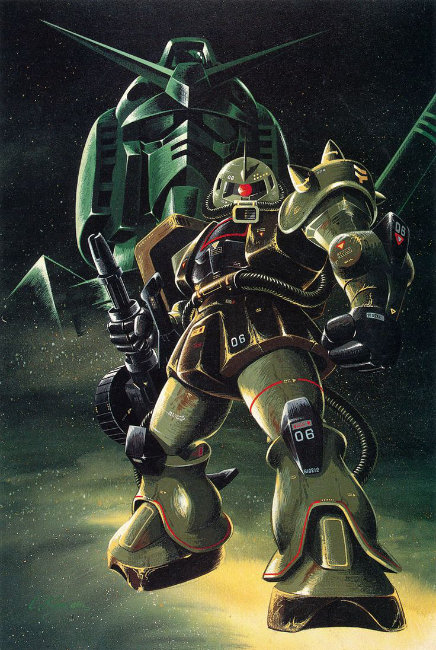
An early Okawara concept painting of the Zaku in front of the Gundam’s head
I’m currently rewatching Mobile Suit Gundam, following along with Mobile Suit Breakdown’s ongoing journey through the series providing historical and cultural context and background. At some point in my rewatch, it occurred to me: both MSG and Battlestar Galactica both came out in 1979, and have an incredibly iconic villain robot with a glowing red, single sweeping eye. The mono-eye.
So, of course, I decided I needed to discover more about their shared visual idiom.
“Just give it a monoeye”, or the usual story about the Zaku’s design
So, the usual story that gets tossed around about where design for the Zaku came from is that Tomino gave Okawara free reign to design it how he liked. The toy sponsor, Clover, wasn’t intending to sell Zaku toys, which meant that they weren’t being watched like hawks for marketability (and yet… it’s one of the best selling gunpla models, says me, based on very casual observation).
This gave Okawara permisison to explore two major themes in the Zaku’s design:
- asymmetry design (symmetry made the toy manufacturing process a lot easier)1
- colors outside of the usual bright primary spectrum (easier to manufacture, and more marketable to children)
The only stricture Tomino reportedly gave Okawara was “give it a monoeye”.
This story is one of those things that are just accepted Gundam legend. Thankfully, with some digging, you can find solid references. This is from an interview Okawara did with the Sankei newspaper in 2015 for his big design retrospective exhibition, translated by @kraker2k:
For “Mobile Suit Gundam” the “Zaku” was originally not meant to go on sale so I was given a lot of freedom with the design, I had a lot of fun designing it. Director Yoshiyuki Tomino only had a single design request for me and that was the “mono-eye”, other than that I designed the [sic] everything else myself.
More recently, the heroic @wantstobeapanda has translated an interview with the many of the creators of Mobile Suit Gundam that was released on NHK this month for the show’s 40th anniversary. In Okawara’s own words:
The Gundam, Guncanon, and Guntank were only possible after collecting and condensing the pooled ideas of the staff and sponsors. The enemies on the other hand usually weren’t sold as products, so I had a lot more fun creating the Zeon mechs…
I had complete freedom. All Tomino wanted was a mono-eye, everything else after that was entirely up to me. Before coming into this industry I worked with apparel, so the Zaku had a business suit sort of design. After hearing from Tomino about the mono-eye, it took me only about a week to turn around a design. The second draft became the final draft. They really let me do whatever I wanted.
Looking at the books I’ve collected, it’s clear that the Zaku went through a few iterations before it was finalized. It gets to looking roughly like the Zaku we know quite quickly, but there are one or two early outliers. Here’s a picture of a very early (possibly first) draft from Gundam Age2, page 79:
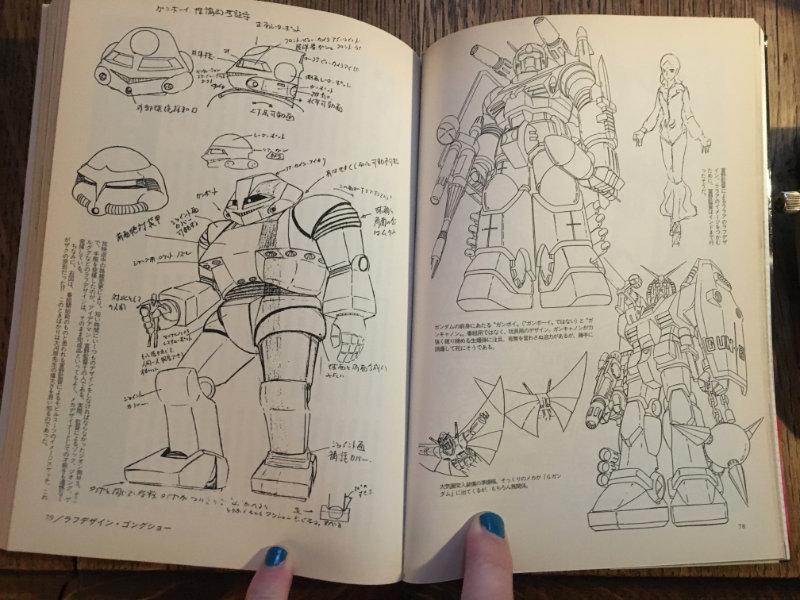
A very early Zaku design showing two eyes… also, can you imagine if the Gundam had batwings???
In a nutshell, the usual story is that Okawara got to do whatever he wanted as long as he gave it a single eye. The two questions that motivate this article are
- why did Tomino insist on the monoeye?
- given so much freedom, where did Okawara pull inspiration for the Zaku from?
Let’s see if we can’t find out.
General resources
There are some really good articles, and even interviews with Okawara, that talk about the design process more generally, and what it was like to work on the show at the time. They don’t go deeper than off-hand mentions of things like the business suit, but they are absolutely worth reading if you have the time:
- Interview with Okawara by Ollie Barder from Forbes, in which he talks about his process and approach, and which MS he really had influence over (archive)
- a really great dive into the Zaku’s impact and ongoing influence from Grant Jones at Zimmerit.moe. It focuses primarily on the history of the Zaku since it was first created, and less on its design origins
- the article from the Sankei newspaper, translated by @kraker2k is a nice mini-biography of Okawara
Unfortunately, these are usually too general for our purposes, although their insights into Okawara’s approach and attitude (which is delightful–he just loved to do the work he was doing) are useful.
Beginning the search
Trying to find out exactly where the Zaku’s design sprang from, and whether it was related to the Cylon, led me down a rabbit-hole trying to find out the origin of this eye. Was the Zaku copied from the Cylon? The other way around? Do the two share some referential DNA? I ended up importing some very cool Gundam art and design books, some very old sci-fi magazine back issues from Japan, and spending a good chunk of time researching robots in film in my search to find out.
I’m going to take a somewhat meandering tour through this, but I think it’s the order that makes the most sense.
First things first, in case you haven’t seen either the 1979 Cylon Centurion, or the Zaku, here we are.
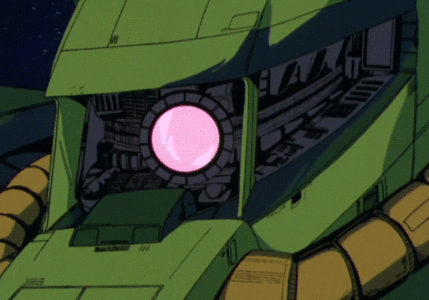
A Zaku’s eye sensor sweeps to gather data
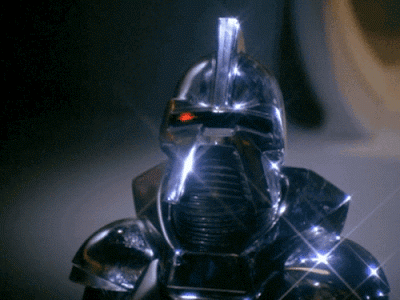
A Cylon Centurion eye sweeps, also to gather data
Quick note about veracity of sources
I’m trying to work with primary sources wherever possible, but… it’s a little hard considering I don’t speak the language. I’m relying a lot on a wonderful community of fan translators, Google translate, Chrome’s built-in translations, and a few other things. I’m also falling back to secondary sources where I have to.
There are also a lot of accepted stories around that don’t have good documentation. Things like Char being named after Charles Aznavour, who was very popular with women in Japan at the time, have some credibility, but can still be hard to authenticate in the way they’re usually told.
Also, it’s worth noting that Tomino is notorious for contradicting thing’s he’s already said, as well as commonly accepted critical stances (like that the Gundam is inspired by Samurai armor…). Basically, this can all get a little grey. But we’re going to do the best we can, ‘kay? Okay!
So let’s dive in.
Initial search failures
I spent a long time putting search terms into engines in some combination of “zaku”, “gundam”, “battlestar”, “cylon”, “monoeye”… without much luck.
The good thing is that this eventually lead me to that Zimmerit.moe article I mentioned, which was a great read on the general history of the Zaku. I highly recommend reading it. The Zimmerit article is great, but is more interested in tracing the ongoing history of the Zaku and its ongoing impact on Gundam, and Japanese pop-culture in general than the specifics of the design’s roots.
There are also a scattering of fan-translated interviews with Okawara, but if the origins of the Zaku ever come up, they generally rehash the usual story (which is incomplete!) of where it came from.
I eventually resorted to buying random art and design books on Gundam from Mandarake, which, if I’m honest, was financially irresponsible (but now I have awesome Gundam stuff), but I got lucky and got a hit reasonably early on with an interview and an old magazine ad for Barbarella (yea, the Jane Fonda movie). I’ll get to that in a second.
History of cinema robots and cyclopses
Until I got the lucky break, I was casting a wide net, and trying to make educated guesses about what might lead to more information:
- looking for BSG ads that aired in Japan (I could only find a few from CBS)
- other instances of movie robots with a mono-eye
- any movie monsters with a mono-eye
I’m going to leave the BSG ads avenue for now–it didn’t really go anywhere. The history of other mono-eyes in cinema is worth a quick tour though. For obvious reasons, I’m limiting these to things that occur before 1979. These are the major ones:
- Gort, from The Day the Earth Stood Still (1951)
- Cyclops from Jason and the Argonauts (1963)
- HAL 9000 from 2001: A Space Odyssey (1968)
- Gigan from Godzilla vs Gigan (1972).
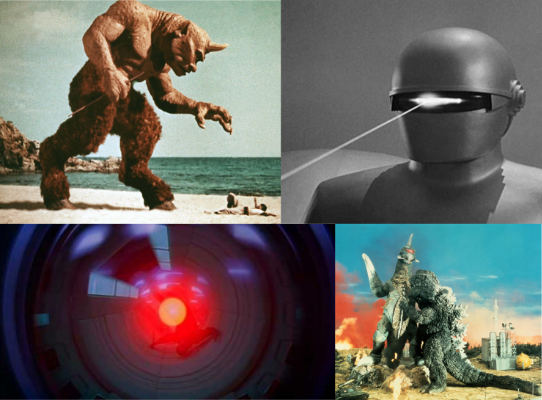
From top-left to bottom-right: Cyclops from Jason and the Argonauts (1963); Gort from The Day the Earth Stood Still (1951); HAL 9000 from 2001: A Space Odyssey (1968); Gigan from Godzilla vs. Gigan (1972)
Of all of these, I want to focus on HAL and Gort. There’s probably some really interesting research to be done (or already done) about the role of the giant cyclops as antagonist. The Zimmerit article puts this really well, so I’m just going to quote it:
It is inhuman.
It is the other.
It is the enemy.
I do want to say briefly at least about Gigan that the fact that it’s a Gojira baddie, is interesting. It gives it a certain… relationship to nuclear explosions and WWII. This I think is important–the Zaku is a nuclear-powered machine, and we see one go critical in the first two episodes of Mobile Suit Gundam, catastrophically destroying Amuro’s home colony in Side 7. But, like Harryhausen’s Cyclops, I’m still going to mark this one off as being the kind of coincidence that happens when people creating popular culture also happen to consume popular culture.
HAL and Gort though… I think we have a little more to work with here.
I’m going to start with Gort. I think this is probably the strongest influence on both the Cylon and Zaku’s eyes. Gort’s eye behaves in a way that looks like it’s a direct antecedent of the other two:
Gort’s red eye isn’t a discrete circle (and technically we can’t know that it’s red either from this clip), and it doesn’t exactly sweep, but it still has what I think, over the next 30 years, would evolve into the Cylon’s sweep.
But this article is about the Zaku. If you rewind that clip to 1:18 (where it’s set to start in the embed), the first thing you’ll see is the visor slowly and ominously lift to reveal the eye panel, which then lights up. Compare to the first time we see a Zaku in Gundam, ever:

The first figure onscreen in Gundam, ever (other than the opening credits)
It’s not a shot-for-shot recreation of the Gort scene… but there are a few strong similarities.
- the camera focuses tightly on the visor area at first
- there is a shared revelation that the eyes behind the mask (visor for Gort, black glass for the Zaku) are fundamentally not human. It’s easy to forget, but the first time you see the Zaku there isn’t anything to give it scale. It could just be a human in a spacesuit. The single eye starts troubling that. Similarly, Gort could be a person in a spacesuit
- next is the slow ignition of the eye, which for both has a pulse where the light brightens then fades slightly. This creates a sense that the eye is focusing when it is first revealed. We as the audience likely mirror this in the miniscule muscles around our eyes3, which helps us understand the alien action
Both of these eyes convey a sense of foreboding. Gort delivers on this shortly after the shot on its eyes by attacking, but the Zaku takes a little longer… though there is good argument that the visual design of the Zaku has some antecedents in Japanese modern history that would have telegraphed to its Japanese audience that it was “Not A Good Guy” already after that first shot (more on this in a minute).
Mobile Suit Gundam and 2001: A Space Odyssey
Before we get into historical influences on the Zaku’s appearance, I still want to talk about HAL and the Zaku. Based on just the red eye, I’d probably just ignore this as a coincidence, but there are other strong indicators that 2001 was a major stylistic influence on Mobile Suit Gundam. Two examples:
Some of the Newtype connection moments, with colors and lights streaming across the screen and the characters’ visors as we dive further into a psychedelic tunnel look a lot like some of Kubrick’s shots:
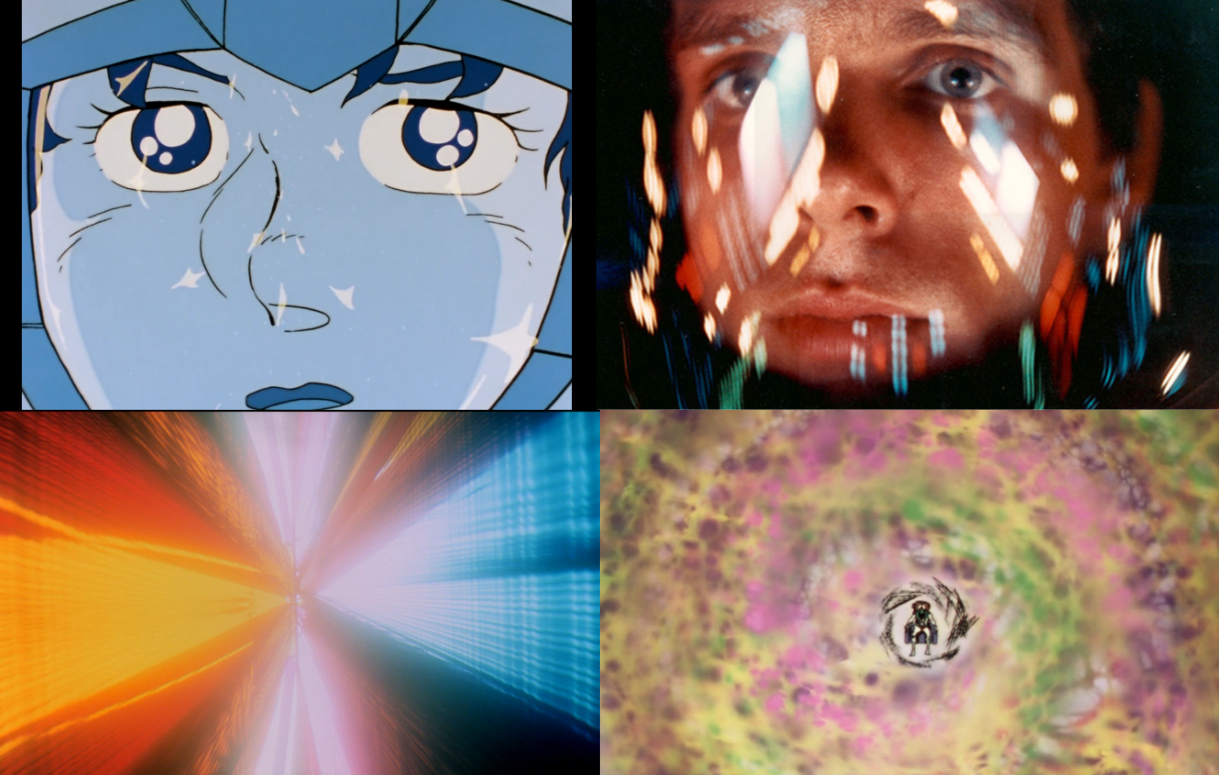
From top left to bottom right: Amuro with Newtype space streaming across his visor in “The Newtype: Challia Bull”, Bowman passing through the Stargate in 2001 with very similar effects, the Stargate’s color pipe, and a very similar color pipe representing Gundam’s Newtype space.
Also, the Ball Mobile Suit (…I guess it’s a Mobile Suit?) looks very inspired by the Space Pod from 2001:

From left to right: Gundam’s RB-79 Ball; the Space Pod from 2001; a variation of Gundam’s Ball looking even more like the 2001 Space Pod… and called a Space Pod
It’s also worth watching all of “A Cosmic Glow”, episode 41, and keeping 2001 in mind while watching that’s the core of the episode’s story.
Considering what else Gundam inherits from 2001 visually, and the movie’s prominence in sci-fi, I think that Tomino had this in mind when/if he said to Okawara “just give it a monoeye”.
It’s worth noting that there’s lots of mythology about Tomino’s love for Kubrick. Again, it’s one of those things that can be hard to track down, though it sounds very right to me. This is a thread on mechatalk.net with a few references to Tomino being influenced by Kubrick (which feels like a gimme even without citation), and even that he said if anyone were to do a live action Gundam, Tomino would want it to be Kubrick (the poster also notes that Tomino said this after Kubrick died… which if I’m honest sounds very Tomino and makes me think this is something he actually said–it’s exactly his kind of shenanigans).
Historical influences on the Zaku’s appearance
This is one of those connections that relies on a careful viewer, since there is little to no documentary evidence of it. But. I’ve been talking a lot with Thom, one of the hosts of Mobile Suit Breakdown (and a very good friend from forever)4 about this research I’m doing.
He’s drawn some rather compelling connections between the Zaku design and Japanese airforce flightsuits:
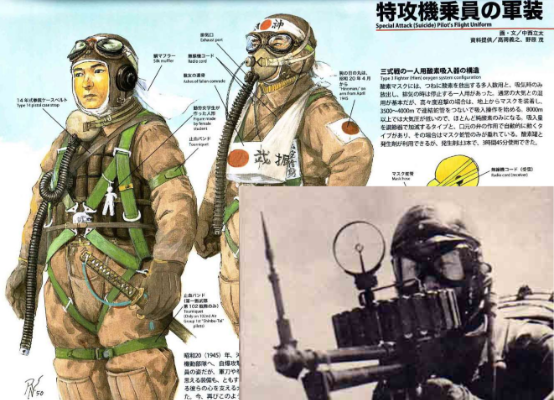
The flightsuit of a Japanese kamikaze pilot, and a JAAF gunner with mask on, looking through a gun’s sight (inset)
I don’t know about you, but that mask on the flightsuit illustration looks a lot like Okawara’s early Zaku sketch. There’s something about the angles of the brow and cheeks, and the sharp separation of the eye areas that makes it an expressive mask.
Also, and it has to be said, that red sun on the pilot’s headband could easily be mistaken for the glowing red eye of a familiar mobile suit.
I really think Thom is right with these two. Their sharp historical connection would certainly work to tie the Zaku to the role of aggressor in a Japanese audience’s mind (whether that makes them the villains is a political question that… is sadly still in play).
I’m about to jump into a visual source for the Zaku that I have some good documentation for, but that doesn’t exclude these visual references. We’re going to wrap back around to this, so just keep these in mind.
Okawara’s design retrospective leads us to Barbarella
I’ve hinted at this before, but the Zaku also takes its design almost directly from Barbarella, which blew my mind when I found out. It was also one of those moments where I had to reread what I was seeing a couple of times. This was the first real documentary breakthrough with a solid primary source I had while researching this. (It was a very cool moment.)
Kunio Okawara, the mechanical designer for Mobile Suit Gundam, had a retrospective exhibition in Japan in 2013. As with many of these, an exhibition companion book was published, Kunio Okawara: Legend of Mechanical Design. This books is gorgeous, and has some very cool prints of some early Gundam designs, as well as designs for Daitarn 3 (the show Okawara and Tomino worked on together before Gundam), and later Gundam series.
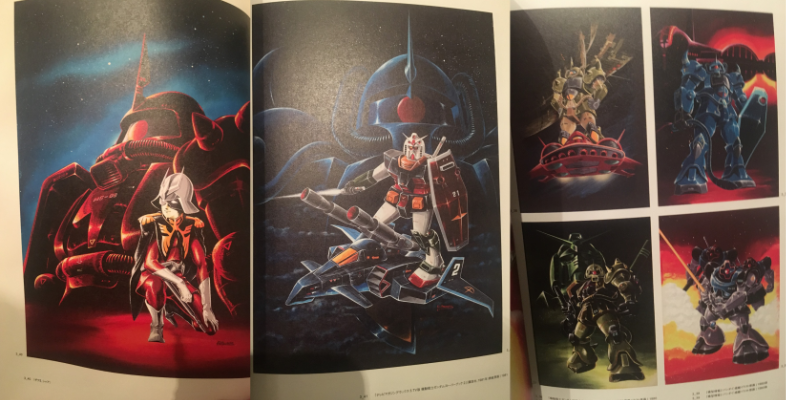
Oil painting concept art by Okawara for Mobile Suit Gundam. Also, it’s hard to take good pictures of books you’re afraid to bend or damage.
In addition to being absolutely gorgeous, this book also includes some interviews with Okawara, translated into English. This is where I struck gold. Here’s the passage that opened up some new avenues for research for me:
Q: …I understand that the original idea for Zaku came from a poster for the film Barbarella that appeared in the first issue of Starlog magazine, and that you were also inspired by the enemy knight Blackguard.
Okawara: At the time, the enemy characters weren’t being turned into merchandise, so you were free to do whatever you wanted. And the [anime director] Yoshiyuki Tomino didn’t ask me to do anything in particular. I even got the okay to do asymmetrical designs, which were hated at the time. This was what led the Zaku to be a character. Creating Zaku also allowed me to discover the approach used for Zeon armed forces.
– “Interview 01”, Kunio Okawara: Legend of Mechanical Design page 16
In case it’s not clear (and this threw me off for far longer than I’d like to admit, until Thom corrected me), the Blackguard in this case is one of the names for the enemies in the Barbarella poster, not a different enemy knight. They are also called Leather Men.
I want to pull a few things out of this:
First, I love that he calls the mechanical designs characters. I think it’s a very smart (and correct) point of view. Mobile Suits aren’t all that different from masks in theatre, which do a huge amount of work to communicate character.
Second, I just want to call out that this report of Tomino having no instruction is contradicted in other sources (notably Gundam Age), though these kinds of contradiction are honestly everywhere. The truth is likely some combination of them.
Third, it’s pretty cool that the entire Zeon aesthetic spun out of this one MS.
When I first read this it didn’t really hit. Then I reread and freaked out.
So, let’s look into that Barbarella poster…
The Barbarella poster
For the Barbarella poster, I was pretty sure it was the main poster for the movie, the one many of us know:
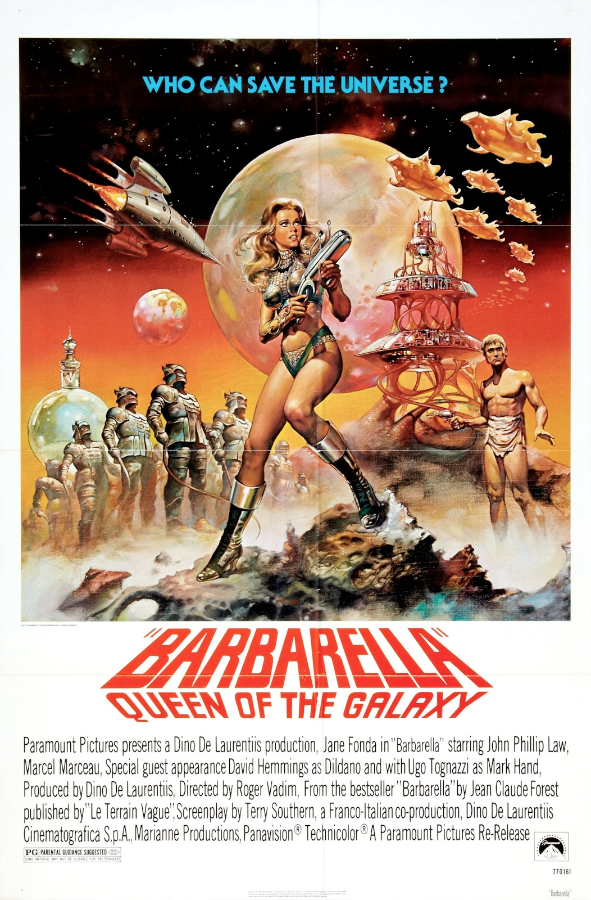
The Barbarella poster most of us know
When I tracked down this specific back-issue from Japan, I was right. There were also some extra surprise goodies in the issue, but I’ll get to those in a minute. Here, in all my bad-photo glory, is the image that inspired the general look of the Zaku:
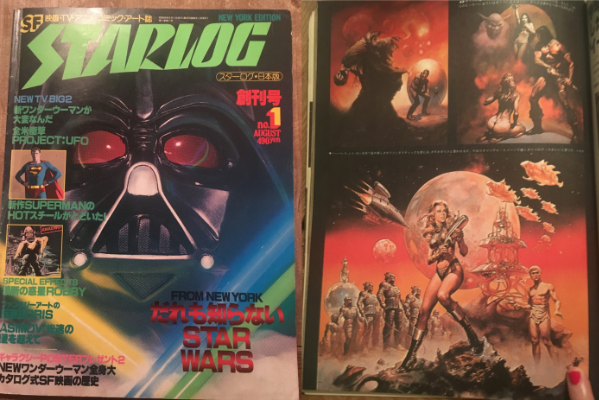
The holy grail: the first issue of the Japanese edition of Starlog. Cover on the left, Barbarella art on the right.
Getting this magazine issue in the post was far more exciting than it had any right to be. I can’t read it, the print quality is… old, let’s say, and all of the content is 4 decades out of date (though I have wondered what would happen if I tried to send away for the mail-order geek-gear advertised in the back pages). And yet… this is a piece of Gundam history, and I am nothing if not a giant Gundam nerd. It was thrilling.
But back to business. You see those angry-looking dudes in the armor on the bottom left over there? Yea. That’s the Zaku’s grandpappy. I’m going to point out some relevant design elements that show up on the Zaku or elsewhere in Gundam.
- the whips that appear to protrude from the arm get used on the Gouf
- the fins on the side of the helmet show up in an early Zaku design
- the armor’s skirt shows up on the Zaku, Gouf, Dom… most Zeon MS to be honest (I’m guessing this is one of the ways in which the Zaku design process influenced a lot of the rest of the Zeon designs)
- that tightly cinched waist under a powerful chest
- the ribs along the chest look a little like the T-shape on the Zaku’s cockpit design
- the armored pauldrons appear on both the Zaku and Gouf shoulders
- the sharp dip in the visor looks familiar, though more like the Gouf’s angular face than the Zaku’s
In fact, altogether I see a lot of similarities between these baddies and this second round Zaku draft:
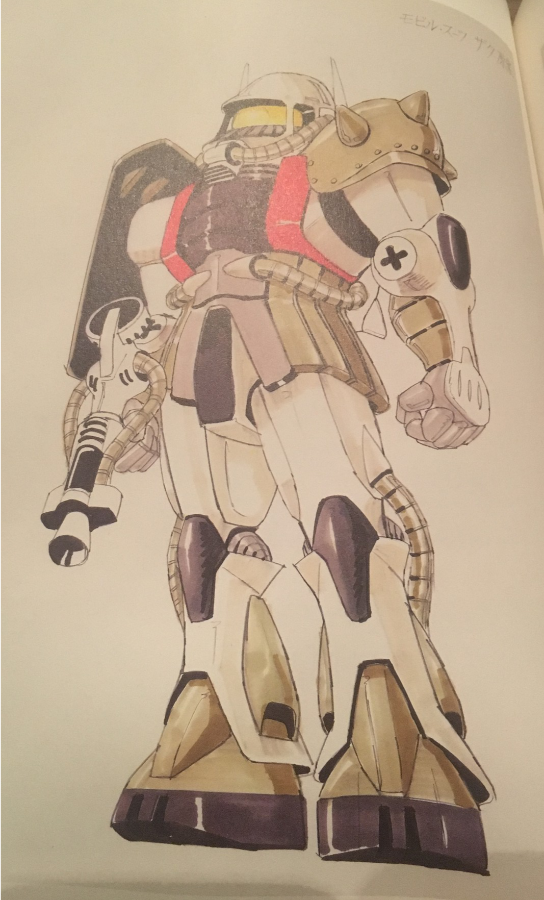
The horns on this Zaku don’t survive to the final design. There are also better versions of this image out there, but the horns often disappear in the transparencies
I think it’s also interesting that in the recent interview Okawara mentions the influence of the business suit on the Zaku’s design. I can kind of see that dovetailing with the Barbarella baddie. If you do an image search for “1980 business suit” you get a lot of images where the suits give the impression of a slight cinch at the waist, which has the effect of visually broadening the chest. Looking at this Zaku design, and the Barbarella baddie, I can see some visual rhymes.
One last note: it seems that the Barbarella connection has been common knowledge in Japan for some time (which, considering the way it comes up in the interview, makes a lot of sense). That said… it seems like the comparison might have been to Barbarella/Jane Fonda herself, rather than the Leather Men. Thom sent me a link to a blog post in Japanese about the Zaku’s design influences (seriously, if I had known about this earlier it might have saved me a lot of work), that includes this humorous image:
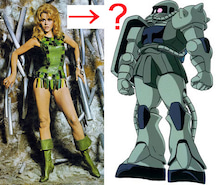
I mean… they both wear a skirt?
This isn’t that post’s conclusion. Much like me, they went and found a back copy of the Starlog issue (though they have a leg up… they can read it!). There’s also some comments about the roundness of the shoulders and the Gouf’s whip in there, and they compare it to the same early fin-helmeted Zaku I did. It’s pretty clear there’s something here. (There are some other good tidbits in there, I think indicating that the Gundam’s shield may have been inspired by riot police!)
Barbarella and the Japanese Airforce, combine!
At this point we have two different stories for where the Zaku design came from:
- JAAF flightsuits and gasmasks5
- the badguy from the Barbarella poster
It sees likely to me that they both were in play. I’m going to include some Zaku drafts again, that trace an evolution of the design.
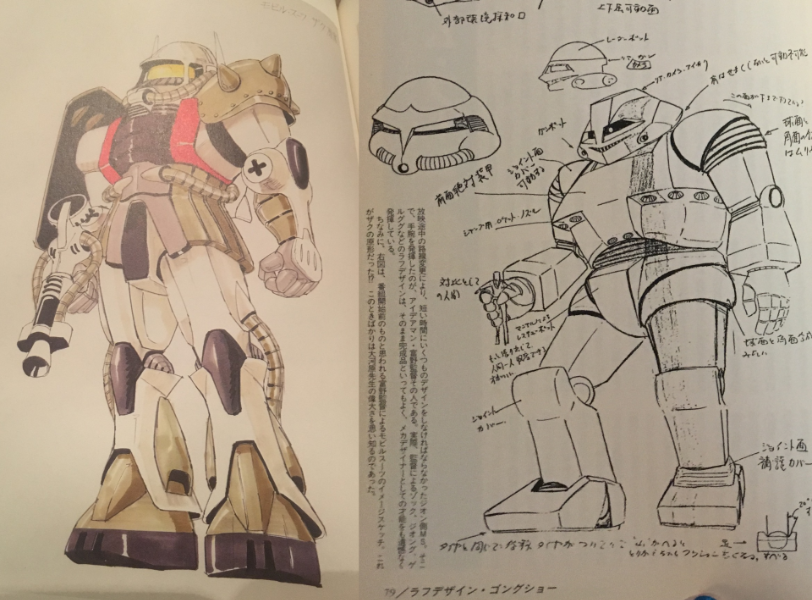
On the left, the more refined (but still early) design that shows striking similarity to the Barbarella villain; on the right, the very early design I think was inspired by the gasmask and flightsuit
It’s funny how little these two designs look like each other at first glance, but there are some similarities that carry through from one to the other.
On the earlier sketch, the wide smile-like grate and circular vents to either side of the mouth-grate give it a strong sense of, for lack of a better word, sideways-ness.
It’s an emphasis on the lateral axis that I think shows up in the later Zaku head designs, there created by the conduit piping running from the nozzle grates around to the sides.
There’s also already some basic shape taking form with wide hips, slightly narrower waist, and a broad chest again. This might be where Okawara’s business suit influence is showing up.
There’s also that head in the top-left of the sketch page (which again, comes from page 79 of Gundam Age). It’s much rounder, and has the conduiting running from a central nozzle grate to the sides. It also has a central vertical bar that splits its visor. The shape of the head looks more like the later Zaku or Gouf (or possibly even the Gelgoog), but the general structure of it looks a lot like the Zaku I:
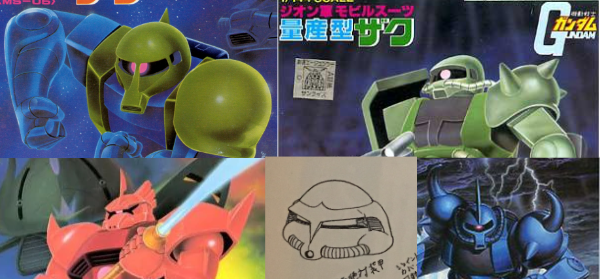
From top-left to bottom-right: the Zaku I head from its original Gunpla box art; the Zaku II head from its original Gunpla boxart; the Gelgoog head from its original Gunpla box art; the sketch head with the split visor; and the Gouf head from its reissued Gunpla box art (the original art didn’t give a good enough view)
The attitude or mood of the sketch, with the face’s angularity and narrowed eyes feels reminiscent of the Gouf’s or even Gelgoog’s more fierce faces. But that split visor is right there on the Zaku I. Also, I wonder if the the up-pointing ornamentation in the sketch has a faint echo in what I lovingly call the Zaku I’s cowlick (that funny fin at the back of its head).
Coming back to the possibility of cross-pollination with Battlestar…
Early on I despaired of connecting BSG to Gundam directly; the search was not fruitful. I figured because of production and import schedules that there wouldn’t have been opportunity for cross-pollination.
That changed when the first back-issue of Starlog arrived. The first few pages of the magazine are given over to ads and promotional material. Which included ads for the upcoming sci-fi epic Battlestar Galactica:
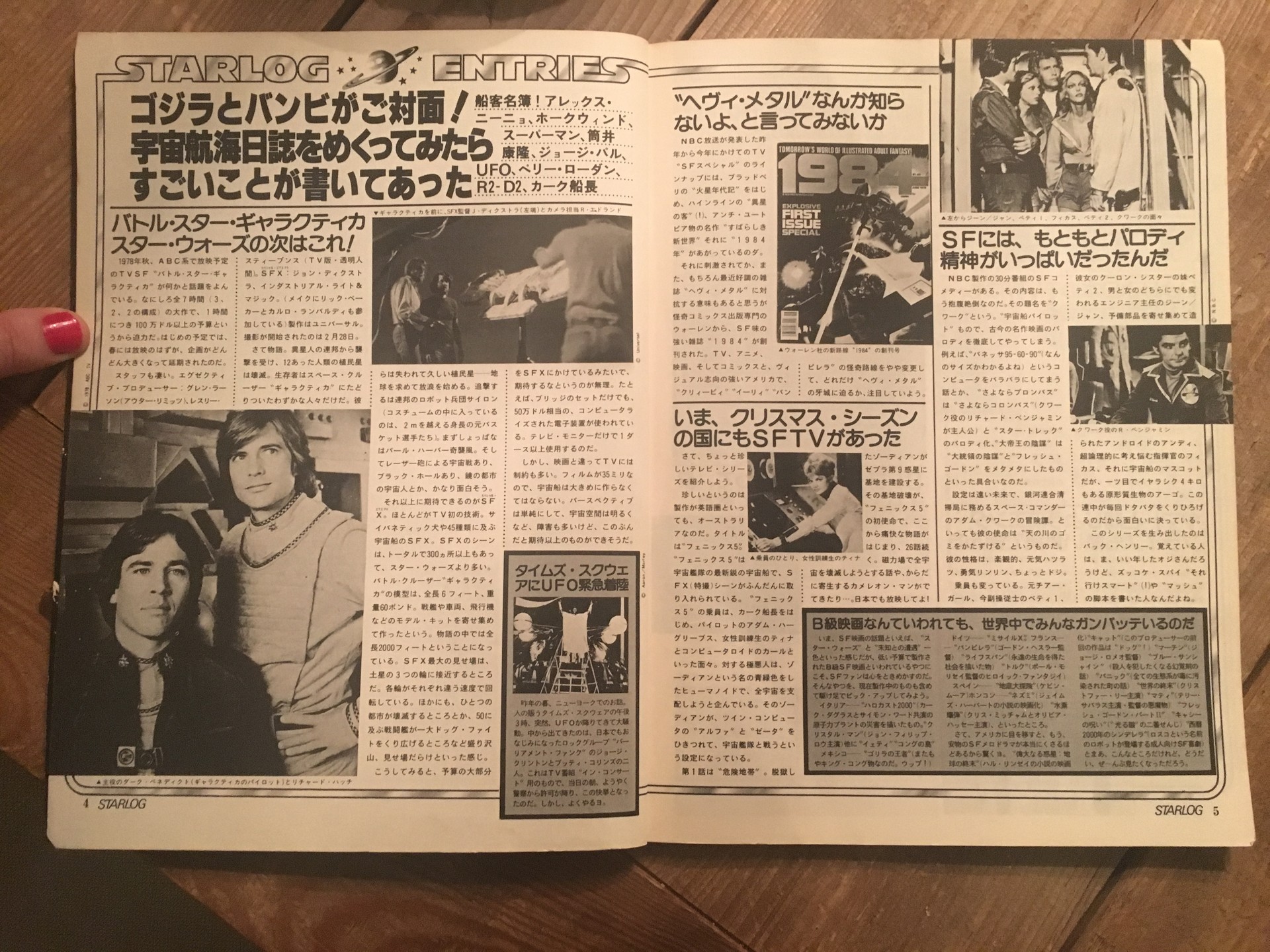
Advertising for Battlestar Galactica in the first issue of Starlog from August 1978
It’s not a smoking gun connecting the Cylon Centurion to the Zaku yet, because there aren’t any Centurions in this two-page spread. But it does mean that there was already cultural exchange and knowledge of Battlestar in Japan at the time, which means that pulsing, sweeping Cylon eye could have influenced Tomino and Okawara.
When I saw this I immediately went back to Mandarake to get more back issues, specifically those from the end of 1978. Issue 2 was unavailable, but I did get issue 3 from October. It does have Centurions. Lots of Centurions.
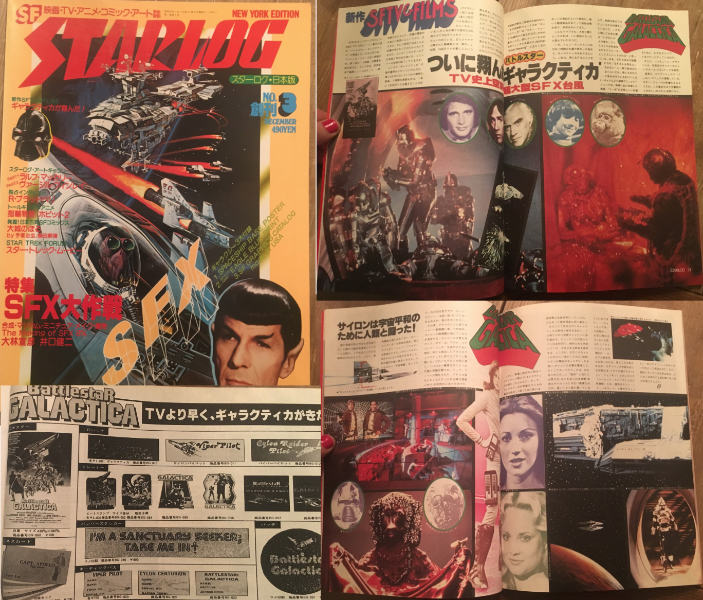
Battlestar content from issue 3 of Japanese Starlog (October 1978): the cover, featuring a Centurion with a red eye; two 2-page spreads including Centurions; and a merch mail-order form, also including Centurion heads
I would be more than willing to bet that there were images of Cylons showing up in other Japanese sci-fi media as early as October, and possibly even August with the first issue of Starlog came out. And, there’s no guarantee that Okawara got the first issue of Starlog immediately on release (I’ve also not been able to find production timelines for Mobile Suit Gundam to get an idea of when the Zaku design would have been finalized).
I’m not trying to say that Okawara and Tomino plagiarized the design here, not by a long shot. I think that given the number and variety of influences on the Zaku design, it’s pretty clear that the Zaku’s design is unique and powerful unto itself (basically the thesis of the excellent Zimmerit article. Seriously. Go read it).
What I do find interesting though, is that two incredibly iconic villains showed up in the same year, and shared a very specific character marker: their monoeye. And most interestingly, they use that marker to convey very different things about themselves and their danger.
When you work with theatrical masks, you talk about how a mask ‘plays’. Different masks ask performers to act in certain ways, which is why Arlecchino (predecessor of the Harlequin, and very much alive in characters like Batman’s Harley Quinn) pushes performers to very precise, exaggerated, sometimes extraneous, fast, and overblown movements that usually create comedy.
Masks also have what’s called a ‘countermask’, a secondary character that is usually the opposite of the masks’s primary character, when the mask is played differently. If you think about Harley Quinn, she can jump between mask and countermask very quickly: from zany bouncing comedy play, to murderous and sharply focused direct play. The Joker also does this incredibly effectively, and as a side note I think these two are part of the reason that Batman: The Animated Series was so excellent.6

The Joker’s two faces… I’ll see myself out.
Given the similarity of the Zaku and Cylon Centurion’s masks at the level of their physical construction, I find it useful to think about their differences in terms of the way their monoeyes play.
The Centurion’s simple sweeping eye makes it seem truly alien to us. When we humans scan our environment and look around, it’s a series of focal points. Our eyes move, dial in, and perceive for a moment. Then we repeat. The Cylon’s constant and un-mammalian sweep is almost the opposite, and I think one of the reasons they are so imposing and unnerving as villains7.
The Zaku on the other hand moves and focuses its eye in discrete movements much like we do, but here, it’s the lack of a second eye that really gets under the skin and communicates danger.
Having a single, expressionless eye ignite and swivel to focus on something communicates a singularity of purpose that is often associated with predators. It evokes the image of a tiger stalking prey, its head staying perfectly level and still even as its body rises and falls with its steps and the terrain. For the Zaku, having a single eye communicates that it is fully focused on whatever it is looking at.
Wrapping it up
This has been a very interesting dive into the background of the Zaku. When it all started, I had the idea that there might be a connection between the Cylon and the Zaku. I still can’t be 100% sure that that’s the case, but considering the timing of when Battlestar was being promoted in Japan in relation to when Okawara was looking at Starlog issue 1 for inspiration, it seems likely to me that the Zaku is in a conversation with the Cylon.
Tomino is too canny and creative a director for this to be anywhere close to the realm of plagiarism. He has a history of taking established tropes and doing something new with them (what else is Gundam if not a reinvention of the mecha anime, using an existing set of symbols to tell a very different story?).
If Tomino did see the Cylon before telling Okawara to give the Zaku a monoeye, and even if that was what gave him the idea, all we need to do is look at the difference in the stories that these two monoeyes tell to know that Tomino is reinventing a symbol to tell his own story. Where the Cylon’s eye creates danger by being sweeping and inhuman, the Zaku adds articulation and a more human play to its mask, and achieves a much more familiar kind of danger–the danger we sense in a mind that we can fathom, through its more familiar play.
They’re both fascinating evolutions of Gort’s eye, and maybe even HAL’s.
Beyond the eye, I did not expect the variety of influences on the Zaku’s design that I found. That it combines Barbarella’s stormtrooper, JAAF flightsuits and gasmasks, and even business suits, is surprising. And the ability to trace those through the versions of the Zaku, and even into the Gouf and other mobile suits, is very cool.
It all comes together into a design that has stood up for 40 years. If you spend enough time in Gundam fandom, you often hear that it is as influential in Japan as Star Wars, and the Zaku is a big part of that. Unlike so many other mechanical designs over the years, it is still relevant and compelling, and I think that its real-world links, and the story that its single articulating eye tells are a big part of why it sticks in our minds and imaginations.
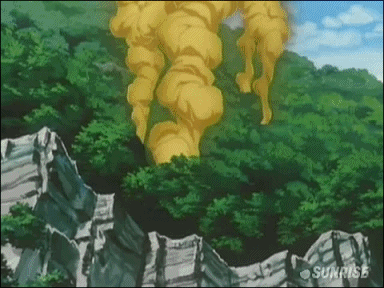
Zaku… LAUNCH!
-
“Interview 01”, Kunio Okawara: Legend of Mechanical Design page 16 ↩
-
Gundam Age (published April 9, 1999, ISBN 4-89691-379-5) is a book that celebrates Gundam and Gunpla for the most part. It’s very cool looking… but I can’t read it. ↩
-
This is something to do with our mirror neurons and the way we use them to empathize with and understand others around us. If you’ve ever been sitting in a horror movie, or, like me, in a clown show, and find yourself mirroring the expressions on the performers’ faces, this is a lot like that. It’s a major part of how we learn, and continues on in play and our consumption of art. For more, check out On the Origin of Stories by Brian Boyd (2009), or any number of neuropsych research. ↩
-
Seriously. We’ve been watching Gundam together since 00 was first airing, and we were both thrilled to have someone else who understood why tf we were so in love with these dumb giant robots (and their dumb pilots who insisted they were the giant robots…). ↩
-
In fact, the Japanese Zaku Wikipedia article makes reference to a gas mask Okawara had lying around as part of the facial inspiration: “There are no such things as “two drafts are decided”. The motif is a suit suit and a gas mask that was suitable for the store at home. However, the thorny ornament of Zaku of the head is not Okawara, but it is due to the idea of general manager Yoshiyuki Tomino. Especially mono eye can be confirmed by image sketch of mobile suits drawn by Tomino.” (Translation by our dear friend Google Chrome and its weirdness… but you get the bit about the gasmask at least). ↩
-
Mark Hamill’s vocal work also does this, turning on a dime from zany Joker to murderous Joker. Similarly, Heath Ledger’s ability to combine these two sides in a performance more grounded in realism is one of the reasons he was so good in the role. That scene where he’s demanding a seat at the table with the gangsters and they blow him off, in part because he appears weak because he’s just… floppy, then turns in an instant and puts the pencil through the crony’s head is some performance magic. ↩
-
io9 recently published an article on the legacy of Farscape where they talk about similar things with Virginia Hey’s approach to the alien Zhaan–she focused a lot on stillness and suppression of very human stop-start motion: “the instinct of ‘fight or flight’ when any worrying stimulus comes their way, and adrenaline gates open, creating floods of stress. I tried to still that whole process, thereby making Zhaan non-human.” ↩
